
















As I sit down to pen this letter, I am filled with gratitude for the opportunity to share something deeply personal with all of you. In this issue of Natural Awakenings, we explore the profound and often overlooked aspect of health— emotional healing. It’s a topic that resonates with me on a very personal level, as my own journey to emotional wellness has been intricately tied to the ancient practice of Ayurveda.
For many years, I was caught up in the whirlwind of life, often neglecting my emotional health in favor of chasing professional success and meeting life’s endless demands. I was functioning, but not truly living. Stress, anxiety and a pervasive sense of imbalance became my constant companions. It was during this challenging period that I was introduced to Ayurveda, and it transformed my life in ways I could never have imagined.
Ayurveda, often described as the “science of life”, is an ancient system of healing that originated in India more than 5,000 years ago and emphasizes the balance of mind, body and spirit as the foundation of health. Unlike other health practices that treat symptoms, Ayurveda addresses the root cause of imbalance, making it a more holistic approach to wellness.
My journey with Ayurveda began with a simple, yet profound realization that emotional health is just as crucial as physical health. This ancient wisdom taught me that our emotions are deeply interconnected with our physical state, and that true healing must encompass both. Through the guidance of Dr. Aruna Patki, an Ayurvedic practitioner in Concord, North Carolina, I learned to listen to my body’s needs and recognize the emotional triggers that were disrupting my well-being.
As I embarked on this path, I discovered that emotional healing is not a destination, but a continuous journey. It’s about embracing our emotions, both light and dark, with compassion and understanding. It’s about creating space for stillness where we can reconnect with our inner selves and find peace amidst the chaos of life.
This month, we delve into various modalities of emotional healing—from the power of herbal teas to stopping the trauma cycle and emotional healing as a family. Each article is crafted with the intention to inspire and support you on your own journey to emotional wellness.
I hope that as you turn the pages of this magazine, you find not only valuable insights, but also a sense of connection to a community that understands the importance of emotional health. We are all on this journey together, and by sharing our experiences and wisdom, we can uplift and heal one another. Thank you for being a part of this journey with us. May we inspire you to embrace the beautiful, complex emotions that make us human and guide you toward a more balanced, joyful life.
With heartfelt wishes for your emotional wellness, Regina
Correction: Exhale Myofascial Release RVA was incorrectly listed as Exhale Massage in the August edition of the magazine.
Publisher Regina Hall Rudolph
Editors Tammie Jones Randy Kambic Martin Miron
Design & Production Patrick Floresca
12220 Chattanooga Plaza, Suite 122 Midlothian, VA 23112 804-495-0325
Regina@NARichmond.com NARichmond.com

Natural Awakenings Richmond
Facebook is a registered trademark of Facebook, Inc.
SUBSCRIPTIONS
Subscriptions are available by sending $12 (for 6 issues) to the above address.
CEO Kimberly B. Whittle
CMO Vee Banionis
Sr. VP Operations Brian Stenzler, DC
National Sales Darleene Lee
National Editor Sandra Yeyati
Editor Brooke Goode
Copy Editor Melanie Rankin
Print Production Specialist Kevin Rankin
Design Director Agnes Mazeikaite
Production Flip180
Customer Service Dani Bucad
Natural Awakenings Publishing Corporation 350 Main Street, Suite 9B Bedminster, NJ 07921 Ph: 239-206-2000
NaturalAwakenings@KnoWEwell.com Natural Awakenings is
Cover image by adwalsh from Getty Images Signature/CanvaPro
© 2024 by Natural Awakenings. All rights reserved. Although some parts of this publication may be reproduced and reprinted, we require that prior permission be obtained in writing. Natural Awakenings is a free publication distributed locally and is supported by our advertisers. Please call to find a location near you or if you would like copies placed at your business. We do not necessarily endorse the views expressed in the articles and advertisements, nor are we responsible for the products and services advertised. Check with a healthcare professional regarding the appropriate use of any treatment.

on






The VOWS Foundation Community Day, starting at 10 a.m., September 7, brings together volunteers to distribute help bags filled with essential items to less fortunate individuals, provide free shopping experiences and street cleaning, all dedicated to giving back and supporting the local community.
Community Day occurs at the beginning of each season. Quarterly, they help clean up city streets to build a sense of community, encourage gratitude and reduce stress and anxiety. Seasonal help bags assist those without shelter in dealing with the weather.
Working together to pack these bags filled with various items and a bagged lunch, fosters empathy, compassion and social skills. VOWS has been fortunate to partner with Amazon, receiving various items for the community. Giving back enhances a sense of purpose, boosts self-esteem and builds confidence.
Admission is free with registration at Tinyurl.com/Community-Day-Tickets. Location: 2927 West Cary St., Ste. A, Richmond. Volunteers are welcome. For more information, visit VowsFoundation.org.



The 20th annual Richmond Folk Festival will be held from September 27 through 29 on downtown Richmond’s historic riverfront. The festival has become one of Virginia’s largest, drawing fans each year to celebrate the roots, richness and variety of American culture through music, dance, traditional crafts, storytelling and food.
Presented by Venture Richmond Events, in partnership with the National Council for the Traditional Arts (NCTA), Virginia Humanities, Center for Cultural Vibrancy, Children’s Museum and the city of Richmond, the event hosts 200,000 people over a three-day weekend, featuring six stages and showcasing music and dance from more than 30 performing groups from around the nation and the world.
Admission is free. For more information, visit Tinyurl.com/RichmondFolkFestival
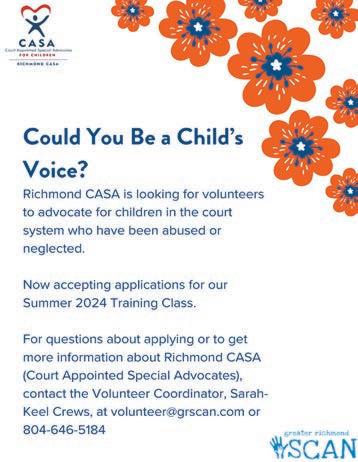
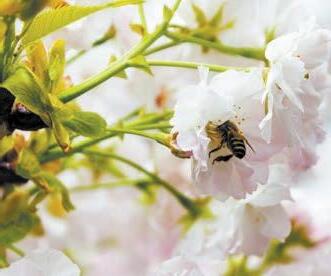
Richmond’s Maymont Park will host PollinatorFriendly Container Garden Workshops from 6 to 8 p.m. on September 18 and 19. Attendees can create a beautiful container garden with guidance from Maymont staff in a make-andtake workshop and learn how to customize and care for a container garden. Guests should bring their own gloves; all other materials will be provided.
Maymont is a 100-acre green space in the heart of Richmond. They welcome everyone to explore the spectacular Gilded Age mansion, beautiful curated gardens, immersive nature center, interactive farm and rescued animal habitats.
Cost is $60. Location: 1001 Spottswood Rd., Richmond. Get tickets at Tinyurl.com/MaymontPollinatorTour. For more information, call 804-358-7166, ext. 304.
The 33rd annual 43rd Street Festival of the Arts, a fundraiser for the nonprofit CARITAS, will take place from 10 a.m. to 4 p.m., September 14.
Limited to 75 artisans, the juried show encompasses street art to fine art, featuring local and regional artisans. There will be food and music, with The Grateful Dads at 11 a.m., Tin Can Fish Band at 1 p.m., and Janet Martin at 3 p.m.
CARITAS is an active community of caring for people experiencing homelessness and/or addiction.

Admission is free. Location: Forest Hill Ave. and W. 43rd St., Richmond. For more information, call 804-358-0964 or visit CaritasVa.org.



Carole Louie, director of the Center of Reincarnation & Evolution and founder of the Reincarnation Symposium, trained with Brian Weiss, M.D., Carol Bowman, the HCH Institute and the Institute of Quantum Consciousness. She has written a new book, The Cosmology of Reincarnation & Rebirth: A Brief History of Reincarnation & The Evolution of Past Life Regression Therapy.
Louie says, “Millions of people around the world believe in reincarnation, but do they understand how it works? Whether you are new to reincarnation or a follower of its beliefs, The Cosmology of Reincarnation & Rebirth will give you a cross-cultural overview that just might surprise you.”
The book is available in hardcover, paperback and eBook at Amazon. For more information, visit CaroleLouie.net.




Exercise creates microscopic tears in muscle tissues, which the body repairs, and each repetition of this cycle allows muscles to grow back stronger. Contrast water therapy (CWT) is a post-workout recovery method that involves placing sore muscles in alternating hot and cold baths in succession. Data examined from 13 studies and published in a 2013 PLOS ONE review showed that CWT resulted in significantly greater improvements in muscle soreness and reduced strength loss at six, 24, 48, 72 and 96 hours after exercise, compared to rest without any other post-recovery approach. The results of CWT were comparable to other muscle recovery interventions such as cold-water immersion, warm-immersion, compression and stretching.

While food addiction is not considered an official diagnosis, some people have a hard time controlling the amount of highly processed foods they consume. In research published in the journal Gut, scientists analyzed the microbiome bacteria of mice and humans with food addictions. They found that the bacteria in mice and humans with food addictions were different from their counterparts with a healthy food relationship. The food-addicted groups had lower levels of the beneficial Blautia bacteria and high levels of the detrimental Proteobacteria in their microbiomes. When the researchers increased the Blautia bacteria levels in the mice that had become compulsive eaters, the compulsive behavior stopped. While a correlation between the microbiome makeup and eating patterns has been identified, more research is needed to understand whether that relationship is a cause or a marker for compulsive eating.
Lupus is an autoimmune disease in which the immune system mistakenly attacks healthy tissue, damaging joints, skin, muscles, connective tissue and major organs such as the kidneys, brain and heart. According to the Lupus Foundation of America, an estimated 1.5 million Americans have lupus, with nine out of 10 being women. Researchers at Northwestern Medicine and Brigham and Women’s Hospital, in Boston, say they have identified the root cause of lupus. In research reported in the journal Nature, the scientists identified a molecular defect that promotes the immune response in lupus, as well as a way to reprogram the lupuscausing cells to correct the imbalance in the immune response. Work continues to find a safe and effective way to deliver these molecules to the body for reprogramming.
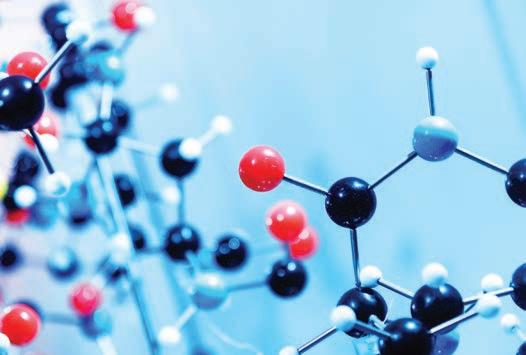

by Regina Rudolph
Emotional wellness can often take a back seat as we navigate through the demands of daily life. However, nature offers us gentle, soothing remedies that can help restore balance to our emotions. Herbal teas, with their rich history in traditional medicine, are a wonderful way to nurture the mind, body and soul. Here is a look at some of the most powerful herbal teas for emotional healing.
Chamomile Tea, the Comforting Soother: Chamomile tea is perhaps one of the most well-known herbal teas for promoting relaxation and emotional well-being. Often referred to as “liquid calm”, chamomile is renowned for its gentle sedative effects, making it an excellent choice for those dealing with anxiety or insomnia. The flavonoids in chamomile bind to receptors in the brain, helping to decrease anxiety and induce a sense of calm. A warm cup of chamomile tea before bed can also help soothe restlessness and encourage a peaceful night’s sleep.
Lavender Tea, the Stress Reliever: Lavender is often associated with its calming
aroma, but when brewed into a tea, it offers profound emotional benefits. Lavender tea is particularly effective at reducing stress and anxiety, thanks to its natural compounds such as linalool, which has been shown to influence the brain’s neurotransmitters. Drinking lavender tea can help alleviate symptoms of stress, depression and even headaches caused by tension. Its calming effects make it an ideal tea to sip during stressful moments or as part of a bedtime routine.
Lemon Balm Tea, the Uplifting Tonic: Lemon balm, a member of the mint family, has a light, lemony flavor that pairs well with its mood-enhancing properties. Traditionally used to reduce stress and improve cognitive function, lemon balm tea is a great ally for those feeling overwhelmed or mentally fatigued. Its calming, yet uplifting effects can help stabilize mood swings, reduce anxiety and improve overall mental clarity. Whether dealing with the pressures of work or simply need a mental pick-me-up, lemon balm tea is an excellent choice.
Passionflower Tea, the Anxiety Alleviator: Passionflower tea has been used for centuries as a natural remedy for anxiety and insomnia. The herb contains compounds that increase the levels of gamma-aminobutyric acid (GABA) in the brain, which helps to lower brain activity and promote relaxation. Passionflower tea is particularly beneficial for those experiencing high levels of anxiety, restlessness or stress. Sipping this tea can help unwind after a long day, making it easier to transition into a restful state of mind.
Rose Tea, the Heart Healer: Rose tea, made from the petals of the rose flower, is not only fragrant, but also emotionally uplifting. The gentle aroma and flavor of rose tea have been shown to have a calming effect on the nervous system. It is often used to help alleviate symptoms of depression, anxiety and grief. Rose tea is also believed to open the heart chakra, promoting feelings of love and compassion. This makes it a wonderful tea to enjoy when feeling emotionally vulnerable or in need of comfort.
Peppermint Tea, the Mind Clarifier: Peppermint tea is more than just a refreshing drink—it is a powerful tool for emotional healing. Known for its ability to clear the mind and invigorate the senses, peppermint tea can help reduce feelings of stress and mental fatigue. The menthol in peppermint has been shown to relax the muscles and reduce tension, making it a great choice for those that experience stress-induced headaches. Additionally, peppermint tea can help improve concentration and focus, making it an ideal beverage for those needing a mental reset.
Tulsi (Holy Basil) Tea, the Adaptogen for Balance: Tulsi, also known as holy basil, is revered in Ayurvedic medicine for its adaptogenic properties which help the body adapt to stress and promote overall emotional balance. Tulsi tea is known to reduce cortisol levels, the hormone responsible for stress, and support the nervous system. Regular consumption of tulsi tea can help stabilize emotions, enhance mental clarity and improve resilience to stress. Its earthy, slightly peppery flavor also makes it a comforting drink to enjoy throughout the day.

Herbal teas are more than just beverages— they are potent remedies that can support emotional well-being and help restore balance to life. Whether looking to calm the nerves, uplift the spirit, or find peace during challenging times, there is an herbal tea to suit those needs. So when feeling emotionally off-balance, consider reaching for one of these natural elixirs. A simple cup of tea could be the perfect remedy for the mind, body and soul.
For more information, visit Wellness-Teas.com
conditions such as heart disease, digestive problems, muscle tension, headaches, sleep issues, weight gain, irregular periods, anxiety, depression and cognitive challenges.
by Carrie Gauthier
Trauma can strike anyone at any time. Loss, heartbreak, abuse, violence, displacement, accidents, disasters, health problems—the list of possible traumas is endless. According to the National Council for Behavioral Health, 70 percent of adults have experienced at least one traumatic event in their lives, and more than a third of youth exposed to community violence experience post-traumatic stress disorder (PTSD). Trauma is a factor in most behavioral health and substance-use disorders. While trauma may be part of our lives, it does not need to define who we are or how
we enjoy our lives. Healing from trauma can take time, but it is within reach.
Left untreated, trauma or repeated trauma has a wide range of short- and long-term effects on physical and mental health. Trauma increases stress and keeps the fight-or-flight response on elevated alert, resulting in the release of chronically high amounts of cortisol into the body. Initial reactions may include exhaustion, numbness, sadness, anxiety and dissociation. Excessive cortisol increases the risk of serious health
Trauma is a common precursor to addiction, because individuals often turn to substances as a coping mechanism for their emotional pain. The use of drugs or alcohol gives trauma sufferers a reprieve from their chronic stress by producing pleasure and reducing negative feelings, and may even slow their central nervous system. Untreated, trauma can lead to a vicious cycle where one condition feeds the other.
While medications such as antidepressants and antipsychotics can be effective in treating trauma symptoms, they may fall short in addressing the root cause. An integrative approach to trauma healing adds evidence-based therapies to tackle the underlying causes and promote long-term recovery.
James Greenblatt, a board-certified functional and integrative psychiatrist and founder of Psychiatry Redefined, believes in a broader view of psychiatric care. “For

example, if our patient is suffering from depression and we were to tell them they should exercise because it’s the best antidepressant we have, that could come off as incredibly insensitive, ruin our chances of gaining their trust and add to their feelings of helplessness and isolation. Alternatively, if we show them how to recover their motivation and energy, that is the way to begin the relationship.”
“Our bodies are different, and our genetics are different. How we react to stress and trauma are different too. I start with lab and genetic tests to see if there’s something I can optimize biologically. Then we supplement any nutritional deficiencies to restore their functionality and increase their energy. These tests also partially help inform the way we design the complementary healing modality plan. This is the piece that gets missed a lot,” says Greenblatt, adding that he tests depressed patients for a vitamin B12 deficiency, which may contribute to depression, anxiety and even psychosis.
Children are particularly susceptible to trauma, and an adverse childhood experience (ACE) can pose lifelong impacts. According to the U.S. Centers for Disease Control and Prevention, 64 percent of adults say they have had at least one ACE, and 17 percent say they had four or more by age 18. ACEs can rob kids of the magic of childhood, disrupt their development and lead to maladaptive behaviors in adulthood.
Aimie Apigian, a double board-certified physician in preventative and addiction medicine and founder of Trauma Healing Accelerated, started her work with attachment and trauma by working with adoptive families to help their children with attachment insecurity. She explains that childhood traumatic experiences can result in “underlying mistrust—literally wiring a child’s nervous system, brain and body for survival—and overwhelm connection, security and safety.”
Somatic therapy is one modality that Apigian integrates to assist individuals on their trauma-healing journey, helping them connect with their bodies, learn to understand its messages and resolve stored trauma. Apigian explains that just 10 minutes of sequential somatic exercises over 21 days can restore a sense of safety. “For each person, the specific improvement or the degree of improvement will be different, but there will be an improvement as soon as we shift our biology into one of safety rather than of danger.”
By following an essential sequence to safely address stored trauma through somatic exercises, Apigian says people “experience 30 percent less depression, 30 percent less anxiety, 30 percent fewer digestive issues, 30 percent improvement in energy and a 60 percent increase in their feelings of safety. The essential sequence has to start with creating a felt sense of safety, then a sense of support and then opening up while pacing our process. It is such a powerful way to empower them for their lifetime.”

Inner-child work can help develop a dialogue to reach the place where we hold past emotions, memories, beliefs, hopes and dreams. “I tell people when they’re starting this journey, if they put their hands on their belly above and below their bellybutton and just let the hands be there, that will calm down an aspect of us so that it begins to feel safe. It’s called the basic self,” says Dr. Lin Morel, a trauma management specialist and founder of Beyond Words Group. “It’s an aspect of our consciousness that is roughly 5 years old, if you were to give it an age. So it gets very fearful, and if it’s not loved, it will act out.”
According to Morel, embracing the basic self can help people out of some of the darkest corners of trauma. No stranger to childhood and adult trauma herself, she empowers her patients with the W.I.N. protocol (willingness, intention, neutrality), which offers them a fresh approach to handling challenges while developing their intuition and regulating emotions as a neutral observer.
There is growing evidence that mindfulnessbased practices such as meditation and yoga aid in shifting focus from the negative to
the positive aspects of experiences. These techniques calm the nervous system and empower individuals to take control of their narratives and become more resilient.
A 2017 review of trials involving 650 trauma sufferers that underwent mindfulnessbased stress reduction, yoga and mantra repetition was published in Psychological Trauma: Theory, Research, Practice, and Policy. The researchers concluded that meditation was an effective treatment for PTSD and depression symptoms as compared to the control groups.
A 2022 systematic review of 149 records and 11 peer-reviewed articles published in the International Journal of Environmental Research and Public Health found that those that practiced yoga had an increased sense of self-compassion, felt more centered, developed coping skills, had a better mind-body relationship and improved their relationships with others. Participants also experienced a feeling of safety in yoga classes that included others recovering from trauma.
Hypnotherapy is a mind-body practice that uses a trance-like state of deep relaxation

to treat psychological and emotional disorders. Guided imagery, progressive relaxation and suggestion therapy are used to explore thoughts, feelings and memories that may be hidden from the conscious mind. Self-hypnosis techniques are also taught for ongoing support, empowering individuals to continue their healing outside of therapy sessions. A 2016 meta-analysis published in the International Journal of Clinical and Experimental Hypnosis concluded that hypnosis is effective in alleviating PTSD symptoms.
“A miracle, simply, is a shift in the mind. Once you find the root cause of the problem in the mind and bring that to consciousness, we’re shifting from ego to true self, from fear to love, from illusion to truth,” says Matthew Brownstein, executive director of the Institute of Interpersonal Hypnotherapy. “Through hypnotherapy, that shift is actually remarkably easy. You can shift as quickly as I can snap my fingers. So, basically, when you change your mind, everything changes. When a decision is made, it stays in place until you choose again.”
Carrie Gauthier is a writer in the healing arts with interests in clinical and transpersonal hypnotherapy.


As people become increasingly aware of their environmental footprint, planting native trees stands out as an impactful action. In addition to their beauty and shade, indigenous species offer numerous other benefits.
According to the National Wildlife Federation, loss of habitat is the primary threat to wildlife. The U.S. Department of Agriculture (USDA) recommends planting native vegetation to maintain a biodiverse, robust and resilient ecosystem. Because these varietals have evolved over centuries to adapt to the local soil and climate, they are hardy providers of essential shelter and food for an area’s wildlife.
The root systems of native trees play a vital role in maintaining soil health, helping to regulate soil temperature, prevent erosion and promote water infiltration. Native trees require less fertilizer and water than non-natives—of particular significance in drought-prone areas.
By sequestering carbon and reducing greenhouse gases, trees contribute to the fight against global warming. They also lower utility bills by shading the house in the summer while allowing the sun to warm it in the winter. Native trees are better equipped to withstand a region’s weather extremes, pests and diseases. The nonprofit American Forests suggests planting species that will be suitable for an area’s expected climate conditions in 30 to 50 years.
Native trees improve air quality by filtering pollutants. They also provide a sense of place and community. A neighborhood with abundant green spaces can enhance mental wellbeing by offering a natural retreat, especially in urban settings. Integrating native trees into community planning can foster a stronger connection between residents and their local environment, too.
• Select the right tree. Consult the USDA tool (PlantHardiness.ars.usda.gov), which predicts a tree’s resilience in light of current and future climatic variables. To ensure genetic diversity, select plantings that are grown from seed instead of cloned.
• Choose the right spot. Make sure the tree’s mature size will fit the available space.
• Mulch and protect. To support microorganisms, control weeds, hold moisture and help a young tree flourish, spread two to four inches of mulch in a ring extending to the tree’s drip line; avoid piling it against the tree trunk. To enrich the soil, choose organic mulch such as composted leaves or aged hardwood bark.
• Water wisely. Research the water requirements of the species. During the initial establishment period, it is important to provide adequate water without overdoing it.

by Marlaina Donato
September is National Mushroom Month, and with it comes bountiful inspiration to plate up some earthy goodness. Whether we follow the nearest woodland path to forage or visit the local market to stock up on our favorite fungi, autumn is the perfect time to appreciate the delicious world of edible mushrooms. From creamy vegan risotto to golden soups, or from daring sautés punctuated with chiles
to savory broths, consuming more mushrooms benefits our palate and well-being.
The Mayo Clinic reports that mushrooms help curb high blood pressure and protect us from neurodegenerative diseases such as Alzheimer’s and Parkinson’s. Most mushrooms available at the market are a good source of B vitamins and minerals,

especially selenium-rich creminis and vitamin D-rich maitakes.
A 2021 Penn State study published in Advances in Nutrition involving data of more than 19,500 cancer patients over several decades reveals that individuals consuming one-eighth to one-quarter cup of mushrooms daily had a 45 percent lower risk of total cancer compared to those that did not. It is believed that the antioxidants ergothioneine and glutathione—present in all mushrooms—contribute to beneficial metabolic processes in the body. Other research is focused on a correlation between white button mushroom consumption and a lower risk of prostate and breast cancer.
Mushrooms have been used as both nourishment and medicine for ages, but their versatility in the kitchen is what delights Sharon Palmer, a plant-based dietician and author of California Vegan and The Plant-Powered Diet. “You can sauté or grill them as a side dish, stir them into soups and stews, add them to grain and pasta dishes, chop them into salads or bowls and include them in casseroles,” she advises. “Use finely chopped mushrooms in lentil patties, veggie burgers, veggie ‘meat’ balls and veggie loaves. You really can’t detect their texture, but you get that rich, savory flavor in the recipe.”
Palmer favors certain commonly available varieties: shiitake and trumpet mushrooms for their reliable, firm texture; oyster mushrooms for their delicate softness suited for stir fries; and petite enoki mushrooms for a crisp addition to salads. To obtain
memorable flavor, gourmet varieties such as porcinis can be purchased dried and easily rehydrated for soups and sauces.
On the wilder side, foraged mushrooms such as golden chanterelles are an annual favorite among connoisseurs. “The mossy, old-growth forests of the Pacific Northwest are some of my favorite fall destinations,” says Langdon Cook, a Seattle-based forager and author of The Mushroom Hunters, who recommends taking a foraging class or joining a mycological society for hands-on safety tips and in-the-field learning.
Cook notes that mushrooms are ideal for vegetarians and vegans because many varieties are firm in texture and pair well with vegetables. “Black trumpet or yellowfoot mushrooms take a basic dish of creamy polenta to the next level, and most grains and pastas will benefit from the addition of fungi,” he asserts. “Try a dry

sauté method: heating the mushrooms in a bare pan until they release their water, cooking off that liquid and then adding butter or oil near the end of the cooking process to brown them.”
While mushrooms can dress up gourmet dishes, they are surprisingly quick and easy for everyday eating, too. “You don’t need to fuss over mushrooms too much,” Palmer points out. “Just rinse in water and pat dry; then you’re ready to cook with them. My favorite way to cook mushrooms is to slice and sauté them in a small amount of olive oil with garlic and lemon as a side dish.”
Cook advises, “Don’t try to cook mushrooms too fast or over high heat. Medium heat is fine. Take your time. Mushrooms are mostly water, and you need to cook off that liquid content to give them a nice sear.” He underscores the importance of cooking wild
mushrooms fully to prevent digestive upset, especially morels, which “absolutely cannot be served raw or undercooked.”
Palmer concurs, saying, “Eating raw mushrooms may cause mild GI [gastrointestinal] issues in some people; cooking the mushrooms typically eliminates this issue.” She also suggests covering the pot or pan when cooking them in soups or stews to lock in flavor and nutrition.
For Cook, the magical lure of mushrooms goes beyond the tastebuds. “To me, morels mean springtime trips to woodlands reawakening from winter slumbers with birdsong and snowmelt, and porcinis mean long summer hikes to subalpine meadows in the Rockies and North Cascades,” he says.
Marlaina Donato is an author, painter and recording artist. Connect at BluefireStudio.art.







YIELD: 6 SERVINGS
FOR LENTIL MUSHROOM FILLING:
1 Tbsp extra-virgin olive oil
1 medium red onion, diced
2 garlic cloves, minced
1 8-oz sweet potato, peeled, cubed
4 oz fresh green beans, chopped
8 oz mushrooms, sliced
1 cup brown or green lentils, dried
2 Tbsp fresh sage (or 1 Tbsp dried)
2 tsp thyme
1 Tbsp whole-grain prepared mustard
½ tsp black pepper
2 cups vegetable broth
½ cup water
2 Tbsp gluten-free soy sauce
¼ cup plain, unsweetened, plant-based milk
2 Tbsp flour
Salt, to taste
FOR SAGE PASTRY CRUST:
1 cup all-purpose flour
½ cup whole wheat flour
¼ tsp salt (optional)
2 Tbsp fresh sage, chopped (or 1 Tbsp dried)
⅓ cup vegan butter
4-5 Tbsp ice-water
Heat olive oil in a heavy pot or saucepan over medium heat. Add onion and garlic and sauté for 5 minutes. Add sweet potato and green beans and sauté for 3 minutes. Add mushrooms and sauté for 2 minutes. Add lentils, sage, thyme, mustard and black pepper and sauté for 1 minute. Add vegetable broth, water and soy sauce and cook for 15 minutes.
Mix plant-based milk with flour until smooth. Stir into vegetable mixture and cook until thickened and bubbling, about 5 minutes. Season with salt, as desired. Transfer filling into a deep pie dish or round casserole that fits 1½ quarts.
While filling is cooking, make the sage pastry crust. Preheat oven to 425° F. In a medium bowl, mix all-purpose and wholewheat flours and salt. Mix in sage. Cut in vegan butter with a
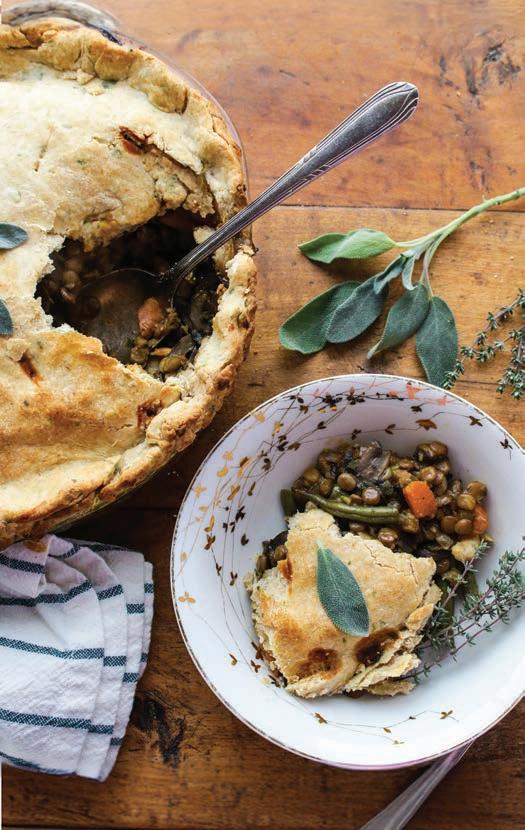
fork until it makes a crumbly texture. Add cold water, 1 tablespoon at a time, and mix using clean hands until it creates a firm dough that holds together but is not sticky. Do not overwork dough, as it will get tough.
Turn out pastry dough on a floured surface and roll out with a pastry roller to create a circle about 11 inches in diameter. Place the pastry over the top of the savory pie and crimp the edges with your fingers to secure the pastry dough to the top of the dish. Cut several vents with a knife along the pie.
Place the savory pie on a baking sheet (in case it boils over) and place in the oven. Bake for about 20 to 22 minutes until golden brown. Remove and serve.
To make this recipe gluten-free, use corn starch instead of flour and gluten-free flour blend instead of all purpose and whole wheat flour.
Recipe and photo courtesy of Sharon Palmer.

Mushroom Bomb Lentil Pasta
YIELD: 6 SERVINGS
1 8-oz package lentil pasta
3 Tbsp truffle oil or extra-virgin olive oil
1 lb mixed mushrooms (enoki, shiitake, cremini, hen of the woods, maitake, oyster), coarsely sliced
2 cloves garlic, minced
1 tsp chopped fresh or dried thyme
1 cup dry white wine
Sea salt, to taste
Freshly ground black pepper, to taste
Cook lentil pasta in boiling water according to package directions. Rinse and drain.
While pasta is cooking, heat truffle oil in a large sauté pan and add mushrooms, garlic and thyme. Sauté for 3 minutes. Add white wine and continue sautéing for an additional 5 minutes to reduce liquid and make a more concentrated sauce. Add cooked pasta to mushroom mixture and toss together. Season as desired with salt and black pepper. Serve immediately.
Recipe and photo courtesy of Sharon Palmer.
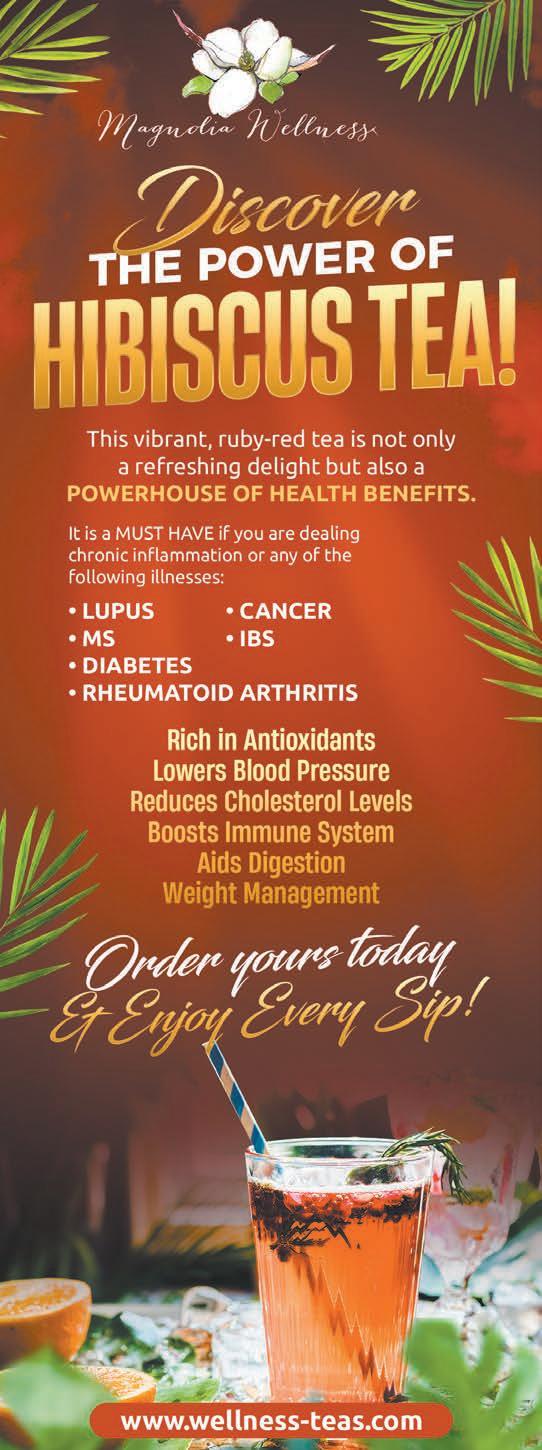
by Carrie Gauthier
The first known reference to yoga is in the Upanishads Sanskrit texts, written 2,500 years ago. The practice originally comprised breath work, and the physical postures developed over time. According to the global data platform Statista, nearly 34 million Americans practice numerous types of yoga, while science continues to provide evidence of its healing potential.
With the frenetic pace of life today, many people live in a permanent state of anxiety. Yoga can ease the panic and malaise by activating the parasympathetic nervous system to decrease stress hormones, blood pressure and heart rate.
“Yoga therapy differs from traditional psychotherapy in scope and aim. Rather than delving into traumas, yoga empowers individuals to be present, moving away from personal narratives,” says Adam Flores, a certified yoga therapist from Port St. Lucie, Florida, specializing in addiction and mental health. “Trained yoga therapists offer grounding techniques and skillful checkins, especially for trauma cases, improving heart rate variability, vagal tone and overall nervous system health.”
A 2011 meta-analysis study published in Primary Care Companion for CNS Disorders indicates that yoga may be an effective

treatment option for severe mental illness, with the added advantage of being less toxic than pharmaceutical treatments.
Post-traumatic stress disorder (PTSD) is a significant issue facing the U.S. military and a growing problem for teens that have experienced violent or traumatizing events. Conventional treatments such as cognitive behavioral therapy and eye movement desensitization and reprocessing have shown limited effectiveness due to high dropout and nonresponse rates. On the other hand, studies have found that engaging in yoga and other mind-body practices can reduce intrusive memories, avoidance and emotional arousal symptoms, as well as anxiety, depression and anger associated with PTSD.
Yoga therapy improves critical factors in addiction recovery, including emotional balance, mental clarity and stress reduction. In a 2021 study published in the Journal of the American Board of Family Medicine, yoga for the treatment of substance abuse disorder was determined to be an effective option.
Yoga has developed into a variety of styles that can meet the goals and objectives of their practitioners. Some of the more popular formats include:
• Vinyasa: An up-tempo class of postures or poses (asanas), often accompanied by high-energy music that typically results in a consistently elevated heart rate. A 2017 study published in The FASEB Journal found that eight weeks of vinyasa yoga improved physical fitness, relieved stress and improved mental well-being.
• Yin: This form of yoga focuses on gentle, passive stretches held for one to three minutes, offering ample opportunity to release stress and tension. Poses are often supported by props such as bolsters, straps, blocks, pillows and blankets. Long, slow, deep breathing promotes relaxation to help the practitioner hold each pose for extended periods of time. Yin yoga
stimulates and stretches fascia, the thin connective tissue throughout the body, as well as ligaments and joints, resulting in increased flexibility.
• Hatha: This is a classic yoga style involving breathing exercises and poses that are held for longer periods of time than other formats. Although the slower, more meditative pace may seem easier, holding a proper pose for extended periods of time can be challenging for the body and mind. According to a 2018 study in the International Journal of Preventive Medicine, 12 sessions of hatha yoga significantly reduced stress, anxiety and depression in women.
• Kundalini: This yoga style prioritizes spiritual growth and awareness, with a focus on energy and chakras. Kundalini awakenings are common via movement sequences, breath work, mantras and chanting. Different studies in 2021 found that kundalini yoga is an effective shortterm therapy for generalized anxiety disorder and can be helpful in reducing the severity of insomnia.
One of the core tenets of a yogic practice is self-compassion, and it is important to resist the inclination for negative self-talk. To adopt the yogic way is to choose happiness over suffering.
“In my experience, the best healing experiences happened by tapping into the body and unlocking the energies we hold onto,” says Paty Renda, a certified Ananda hatha yoga instructor and co-owner of Premah Wellness, in Fort Lauderdale, Florida. “I believe in serious work done through fun exercises such as breath, dance, laughter and movement. A simple, slow and deep hatha yoga practice can create profound changes. Gratitude is another very easy, and yet immensely powerful, practice I infuse into everything I do.”
Carrie Gauthier is a writer in the healing arts with interests in clinical and transpersonal hypnotherapy.
by Marlaina Donato
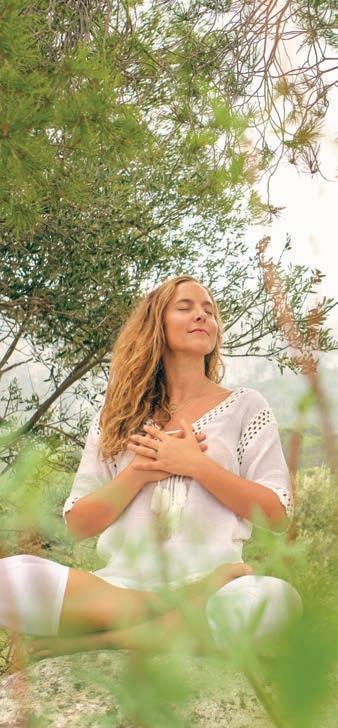
One of the most beautiful aspects of youth is envisioning the future with undaunted optimism, but even the most strategic plan for life can go off the rails. Whether we carry the weight of unprocessed trauma and never quite reach our potential or zoom into the fast lane of success only to be brought down by sudden change, pain is part of every person’s story. The quest for healing and finding our whole self beneath the rubble becomes a
new objective that can be the most arduous but the most significant.
We might accomplish monumental feats, transforming our trauma or going into physical remission from disease. We might even feel a calling to guide others along the path we have come to know so well, but it is important to remember that the deep healing process is a spiral. Our linear brains may be startled when our most gut-wrenching, seemingly resolved issues loop back around, and we are plunged even deeper into the crucible. During these times, it is easy to forget that we are multidimensional beings. A physical injury or illness involves much more than flesh or organ systems, and agonies of the spirit can greatly impact the physical body.
We heal layer by layer—sometimes even layers within layers—and despite our full commitment and steady growth, the task of peeling the onion is never quite finished. One of our greatest challenges is overcoming the illusion that we are failing miserably when we fall out of resonance; evolution is not a course that we can flunk. With each descent, our pain can provide an opportunity to lessen the chasm between mind and body and to acknowledge parts of our being that might need tending. For as long as we inhabit a human vehicle, we will always be in the process of healing something, and that is okay. We can rest assured that our process, like all spirals, will lead us safely back outward to continue our journey.
Marlaina Donato is an author, artist and musician. Connect at BluefireStudio.art.
by Kelcie Ottoes
Emerging sustainability initiatives such as renewable energy, greenwashing regulation, artificial intelligence (AI) applications and biodiversity programs are all being championed by stakeholders for the greater good of our planet.
Renewable energy is derived from natural sources, such as the sun and wind, that are replenished at a higher rate than they are consumed. In 2023, the U.S. Energy Information Administration reported that renewable energy made up 9 percent of total energy consumption from these sources: biomass waste, biofuels and wood (60 percent); wind (18 percent); solar (11 percent); hydroelectric (10 percent); and geothermal (1 percent).
The International Energy Agency predicts that renewables will provide more than a third of global electricity generation by early 2025—surpassing coal—due in large part to increasingly cheaper photovoltaic technology. The quest continues to improve the efficiency, cost effectiveness, adaptability and environmental footprint of existing solar panels. Advanced photovoltaics use innovative materials such as perovskites, organic and tandem solar cells, which may surpass the efficiency of traditional silicon-based solar cells. The use of floating solar panels
and panels above or adjacent to agricultural production serves to minimize land use and increase opportunities for energy production. Flexible, transparent solar cells also allow for their integration into a wider range of applications.
These advancements are also aided by improvements in energy storage. Lithiumglass batteries and redux flow batteries manage the intermittency of renewable energies like wind and solar better and have a lower environmental impact than other batteries. Flow batteries, in particular, show potential as a cost-effective, longterm storage solution.
Greenwashing is the practice of making a product appear to be more environmentally friendly or less environmentally damaging than it really is, and new antigreenwashing laws are being promoted to help consumers make better choices. The European Union has banned environmental claims that are not supported by transparent, verifiable data. It also imposes strict regulations on potentially misleading terms such as “environmentally friendly”, “eco-friendly”, “green”, “biodegradable” and “carbon neutral”.
In a similar move intended to provide environmental transparency and oversight, the California Climate Corporate Data Accountability Act will require companies with more than $1 billion in revenues to report their direct and indirect emissions from energy consumption with third-party certification beginning in 2026. This information will be made public online.
AI is expected to play a larger role in fighting climate change. Some applications include:
• Identifying carbon inefficiencies within a supply chain to influence reduction strategies
• Improving the efficiency and maintenance of renewable energy infrastructure,

optimizing the management of the power grid, forecasting power consumption and managing energy distribution
• Supporting the agriculture industry by analyzing soil data, plant health and weather forecasting
• Boosting recycling rates by using AIpowered machines to sort materials to be recovered
These advancements in AI are not without cost. According to Nathan Childress, Ph.D, a nuclear engineer and CEO of Macorva, “AI’s voracious appetite for energy is straining power grids and causing some tech giants to miss their carbon reduction targets. This highlights a critical need for immediate action in expanding clean energy infrastructure to support AI’s growth.”
According to the Kunming-Montreal Global Biodiversity Framework, a United Nations-led initiative, more than half the world’s population—4.3 billion people— depend on biodiversity and nature for their livelihood, with 70 percent of the world’s poorest and most vulnerable relying directly on nature for their everyday needs. And yet, biodiversity is dwindling at an alarming rate.
“Urbanization and deforestation lead to habitat fragmentation, while pollution— particularly plastic and chemical waste— degrades ecosystems,” says Abdullah Choudhry, chief impact officer at Arbor, a carbon assessment company. “According to the World Wildlife Fund, wildlife populations have declined nearly 70 percent since 1970, highlighting the urgent need for comprehensive conservation efforts.”
To protect biodiversity, volunteers are teaming up with researchers on long-term ecological projects. The nonprofit Biodiversity & Development Institute, for example, enlists citizen scientists with smartphones to identify African mammal, aquatic, insect and plant species for their Virtual Museum project. In Japan, the mobile application Biome
was able to collect more than 6 million species observations with the help of the public. In a study published in eLife, scientists combined these citizen sightings with traditional data to improve ecosystem assessments and protected-area designations.
In a journal article published in BioScience, experts report a growing opportunity for citizen-led research in biodiversity, noting that people onsite are able to identify
under-sampled species and help scientists gain a deeper understanding of ecological interactions among species or habitats. Offering hope for future generations, kids are also getting involved. The Biodiversity Group, in Arizona, offers a K-12 curriculum that encourages biodiversity stewardship at a young age.
Kelcie Ottoes is a copywriter and content creator specializing in sustainability and environmental topics.


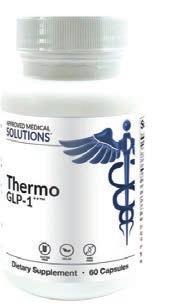


by Zak Logan
For many of us, our hair can feel like an outward expression of our identity, and we may struggle emotionally and socially when it is compromised. According to the National Alopecia Areata Foundation, an estimated 6.7 million Americans suffer or have suffered from alopecia areata (AA), an autoimmune disease resulting in hair loss on the scalp, face and other parts of the body. Whether AA manifests as bald patches or complete hair loss, the conventional courses of action may involve oral prescription medication, over-the-counter topical products and oral or injected steroids that are often unsuccessful and may come with side effects.
There is evidence that stress and anxiety can play a role in AA, as can certain underlying health conditions such as thyroid disease, celiac disease and lupus. Hormonal imbalances and vitamin and mineral deficiencies can also be key factors. Although AA can be a stubborn condition, alternative approaches such as centuries-old Ayurveda and Traditional Chinese Medicine (TCM), including acupuncture, can offer hope.
According to allopathic medicine, AA may be caused by hormonal imbalances or an excessive immune response that attacks the hair follicles, but from the perspective of Eastern medicine, the issue is more complex. Ayurveda, India’s 5,000-year-old holistic-health system, approaches AA and other health conditions from the concept of individual constitution. Energetic forces called doshas are believed to be inherent in all cells and organ systems and embody five natural elements: earth, air, fire, water and ether.
“Our doshic makeup is very unique, with the ratios between the three doshas (vata, pitta and kapha) being different for each one of us. In alopecia, it is most commonly seen as a pitta condition when the metabolic fires within us are excessive and too hot, causing inflammation,” says Virender Sodhi, an Ayurvedic and naturopathic physician, in Redmond, Washington. He adds that for alopecia cases caused by thyroid disorders, in which the hair becomes dry and
brittle before falling out, he would look into the health of a person’s vata, the dosha that corresponds to the element of air.
A 2022 case study of an individual AA patient published in Journal of Ayurveda and Integrative Medicine reported that the patient saw improvement within 15 days of an Ayurvedic treatment plan that included a combination of cleansing, detoxification, blood purification and naturally derived medications. The researchers recommended further study of these techniques. Another study published in the same journal a year later noted the effectiveness of certain Ayurvedic medicines comprised of natural elements, combined with cupping,

in which heated cups are placed on the back, stomach, arms, legs or other parts of the body, forming a vacuum or suction force.
From the approach of 3,000-year-old TCM, imbalances and illnesses are attributed to obstructions within the body’s subtle energetic system. “This is the concept of the life force, or the energy of our body as it takes care of itself,” explains Brian Keenan, a naturopathic doctor and licensed acupuncturist at Sagelight Integrative Wellness Center, in Columbia, Maryland. “In Chinese medicine, qi is the energy of the body, and it flows along a set pattern similar to a well-connected network of roads and highways. Meridians are the names of the major highways an acupuncturist will use to influence the qi flowing through them.”
In cases of alopecia, Keenan would dive deeply to find the origin of the pathology. “The specifics of your symptoms will help an acupuncturist figure out where exactly the problem is coming from, since there can be several issues at once,” he explains. “This is why your acupuncturist may spend a great deal of time asking you detailed questions about every nuance of not just your symptoms but also your whole body’s health.”
A 2022 review of eight studies published in Frontiers of Medicine found that acupuncture or moxibustion (the burning of dried mugwort on or near the body during acupuncture), used by themselves or in combination with other treatment modalities, may be effective in treating hair loss.
Clinical findings published in the Indian Journal of Dermatology in 2017 report that systemic vitamin D levels are lower in people with AA, and improvement might result from supplementation. Recent research also shows that zinc deficiency was noted in sufferers and adding the mineral to the diet might be helpful. Mount Sinai Health System, in New York City, suggests that biotin and trace minerals might foster hair growth and recommends including beneficial foods such as carrots, tomatoes, chard and romaine lettuce.
Practitioners of both Ayurveda and TCM attest to the value of eliminating processed foods as a way to support the liver in its role of min imizing systemic inflammation. They also recommended streamlin ing busy schedules and employing meditative practices to reduce stressors.
For best results, commitment is key. Regarding TCM, Keenan sug gests an eight-week treatment plan of herbs and acupuncture. “Is it possible to see results sooner? Absolutely. But from my experience as a practitioner, it’s better to set realistic expectations, and if we get there sooner, then that’s all the better.”




Therasage is the gold standard for energy healing, naturally healing infrared, negative ions and eliminating EMFs.
Therasage.com
Scan to register for educational webcast to learn more.


A NEW fun and interactive series dedicated to the health and well-being of Preschoolers and their families.
WORLD MUSIC, MOVEMENT, MINDFULNESS, CREATIVE PLAY, TIME IN NATURE & POWER OF THE HEART! SUBSCRIBE today!
Scan to learn more and subscribe.


Founded in 1932, Boiron, the world leader in homeopathic medicines, is best known for its popular Arnicare® line of pain relievers and Oscillococcinum® flu reliever.
BoironUSA.com
Save 20% with code NA20

Zak Logan is a freelance health writer dedicated to holistic living.


OB/GYN-formulated Rejuvenates vaginal tissue, restores natural moisture, and helps prevent bladder leaks.
DrAnnaCabeca.com/ products/julva

by Christina Connors
The mental health of our children is in crisis. According to the U.S. Surgeon General’s 2021 advisory on the youth mental health crisis, one in five children aged 3 to 17 has a mental, emotional, behavioral or developmental disorder.
To turn the tide on mental health, kids need emotional regulation skills, including the ability to identify emotions, self-soothe, obtain perspective, walk in another’s shoes, think flexibly and solve problems. By developing these emotive sensitivities, children can then improve their self-confidence, sense of self-worth and empathy, as well as begin to develop lasting and meaningful relationships.
“Kids will learn to regulate in the face of challenge. The only question is whether they learn healthy or unhealthy ways to do it,” says Brad Chapin, a licensed clinical psychologist in Topeka, Kansas, and author of self-regulation resources for children. “Removing challenges from children isn’t the answer. The focus should be on building self-regulation skills, and then those challenges become opportunities for strengthening those skills.”
In the words of lyricist Stephen Sondheim, “Careful the things you say / Children will listen.” Janet Philbin, LDSW, a certified,
conscious-parenting coach and author, says, “When people become parents, they will tell you they want to parent differently than how they were parented because of the emotional childhood pain they endured. However, generational patterns will more than likely repeat unless the parent has done the emotional work to deconstruct their own childhood pain through coaching or counseling. As a result of doing the necessary inner work, a parent’s ability to connect with their children will improve because they are able to be more connected with themselves.”
“When we choose to look at behavior issues as a lack of skill-development, it changes the story from one of shame and negativity to one of hope,” says Chapin, whose recent book Self-Regulation Skill Set supports adults in their journey to self-regulation.
As with learning any new skill, practice is key. Here are a few fun activities for parents and children to do together to strengthen connections and build emotional regulation skills. Teaching kids when they are young is ideal, but it is never too late to start.
I Spy: While in a store, on a walk or at a park, challenge each other to notice the body language and facial expressions of people (or themselves) and identify the emotion they
might be feeling. This game is a way to practice the skill set of recognizing warning signs when we start to feel upset. Parents should encourage their kids to take notice of the different expressions their peers make while at school to develop empathy and compassion.
The Paws (Pause) Game: To play, the first person who sees a dog says, “paws”, takes a calming breath and puts their hands out like paws. The person with the most points at the end of the excursion wins. This game develops the skill of slowing down the alarm system within our bodies. Parents and caregivers can remind kids that throughout the day when they start to feel their own warning signs of anger or frustration, they can take a breath and “paws” to help prevent acting in a destructive way.
Balloon Party: In this game, parents invite their kids to sit comfortably with them and imagine that they are all preparing for a big party and need to blow up lots of balloons. While blowing up pretend balloons, remind each child to blow them up slowly so they don’t pop. After blowing up several balloons, enjoy a pretend party. This is a fun way to connect with children through imaginative play while practicing peaceful breathing, which helps calm the nervous system.
Christina Connors is a writer, singer and creator of Christina’s Cottage, a YouTube series to strengthen kids’ resilience, connection and joy through music, mindful play and the power of the heart. Learn more at ChristinasCottage444.com.











by Ruth Roberts, DVM, CVA, CVH, CVFT, NAN
Pet therapy, also known as animalassisted therapy (AAT), has long been recognized for its therapeutic benefits across a range of mental health conditions, including post-traumatic stress disorder (PTSD). Psychiatric service dogs are empathetic in nature and intuitively respond to human emotions. These capacities allow them to provide comfort and support precisely when it’s needed, often without the need for verbal communication. These dogs are not just pets but vital partners in the journey toward mental and emotional healing.
Interacting with psychiatric service dogs can reduce anxiety and stress levels by increasing the release of oxytocin, a hormone associated with bonding and stress reduction, while decreasing cortisol levels, which are linked to stress.
Psychiatric service dogs provide a calming presence, which is crucial for reducing anxiety and hypervigilance, common symptoms of PTSD. A study published in Frontiers in Psychology involving 134 veterans with
service dogs found that trained skills such as calming and interrupting anxiety are highly valued by veterans with PTSD, suggesting their critical role in daily PTSD management. The study also noted that untrained behaviors of the dogs are often perceived as more beneficial than their trained tasks, highlighting the intrinsic value of simply having a dog as a companion.
A 2022 study of 82 post-9/11 military veterans published in PLOS ONE reported that their psychiatric service dogs helped them with PTSD by performing calming actions and interrupting the veterans’ disturbing behaviors and thoughts during anxiety episodes. Researchers noted that all of the tasks the dogs had been trained to perform were used daily by the veterans, providing benefits for nearly all PTSD symptoms, except amnesia and reckless behavior. The human-animal bond and untrained qualities, such as companionship, also significantly improved the participants’ symptoms and quality of life.
Psychiatric service dogs enhance emotional regulation and improve social interactions for PTSD sufferers. Their non-judgmental and accepting nature creates a safe space for individuals to explore and manage difficult emotions. Additional research reported in the European Journal of Psychotraumatology demonstrated significant improvements in emotional and attentional regulation among adolescents with PTSD that were asked to participate in a one-year dog-training program.

While the therapeutic benefits for the handlers are significant, the European Journal of Psychotraumatology study also noted that the dogs in the training programs exhibited increased anxiety and decreased attention. This
highlights a critical aspect of AAT: The welfare of the animals must be considered alongside the therapeutic benefits. Training programs need to ensure that the dogs are not overly stressed or burdened by their roles.
Prospective handlers of psychiatric service dogs should choose programs that prioritize the well-being of both dogs and humans through training, support and follow-up care. Engaging with a psychiatric service dog is a significant commitment that requires handlers to invest time in training and bonding with their dogs, as well as managing their emotional and physical needs to ensure a mutually beneficial relationship.
Understanding the legal rights pertaining to psychiatric service dogs, including accessibility in public spaces and accommodations, is crucial. Handlers should educate themselves about local and national laws that protect their rights and those of their service dogs.
Obtaining a psychiatric service dog involves careful consideration of the therapeutic benefits versus the potential stress on the animal. Look for reputable programs that train dogs to assist individuals with PTSD, while also prioritizing the welfare of the dogs and properly matching dogs and handlers.
The integration of psychiatric service dogs into mental health care offers more than just companionship; it opens a dynamic pathway for healing and managing PTSD symptoms. As we continue to explore and understand the unique bond between humans and animals, it becomes increasingly clear that dogs are not only cherished pets but also invaluable partners.
Ruth Roberts is an integrative veterinarian and holistic health coach for pets, as well as the creator of The Original CrockPet Diet. Learn more at DrRuthRoberts.com.
NOTE: All calendar events must be received via email by the 10th of the month and adhere to our guidelines. Email Regina@NARichmond.com for guidelines and to submit entries. No phone calls or faxes, please. Or visit NARichmond.com to submit online.
Saturday, September 7
James River EcoFest – 1-6pm. Dive into a day dedicated to celebrating and preserving our vibrant local environment. Learn how to collect and use rainwater efficiently; join in a community trash cleanup; and discover more about the James River Watershed, local flora and fauna and sustainable living practices. Enjoy a variety of family-friendly activities designed to entertain and educate all ages about environmental stewardship. TheJamesRiver.org. James A. Buzzard River Education Center 2825 Dock St. Richmond, VA. Free.
Sunday, September 8
The Creative Wink – Open House –1-2:30pm. The Creative Wink is a playful, process-oriented class designed to appeal to your inner child. Discover your creative energy through hands-on activities such as simple art, writing and games. 804359-0384 Register at InnerworkCenter. org Innerwork Center 213 Roseneath Rd. Richmond, VA. $10+.
Thursday, September 12
Restorative Sound Healing – 6-7pm. Relax your mind and body through the calming melodies created by a variation of 432Hz-tuned crystal singing bowls, Himalayan singing bowls, Koshi chimes, shell chimes, tuning forks and more. This particular session will focus on clearing and aligning all energy centers, with a primary focus on the energies associated with the astrological sign of Virgo. 804359-0384 Register at InnerworkCenter. org Innerwork Center 213 Roseneath Rd. Richmond, VA. $17+.
Saturday, September 14
Silent Retreat – 9am-3pm. Offerings will include restorative movement and breathing exercises, guided outdoor city walking, meditation sits, journaling and creative expression. A nourishing lunch for varying food preferences will be offered. Register at TheWellCollective.space 13 South 13th Street Richmond, VA. $75+.
Thursday, September 19
ReDiscover The Real You and Your Mission in Life – 6:30-8pm. You exist in two worlds simultaneously: the spiritual and the material. Only through self-understanding can you develop to your full potential. This 90-minute class will fill in all the gaps surrounding your understanding of who
you really are, where you came from and why you are here. 804-359-0384 Register at InnerworkCenter.org Innerwork Center 213 Roseneath Rd. Richmond, VA. $25+.
Saturday, September 21
Maymont Bier Garden – 11am-7:30pm. This two-night, German-style festival is the perfect way to celebrate the change of seasons in a beautiful outdoor setting! Bring the kids on Saturday, when they will find crafts, games and their favorite entertainers in the Kinderzone. Maymont. org 804-525-9000 1700 Hampton St. Richmond, VA Adults $10 Children $5.
Embrace the Power and Inner Peace of Your True Nature Workshop – 12pm3:30pm. Join this workshop to gain the experiences necessary to make your spiritual understanding a practical part of your everyday life. 804-359-0384 Register at InnerworkCenter.org Innerwork Center 213 Roseneath Rd. Richmond, VA. $57+.
Sunday, September 22
Empathy in Action: Navigating Political Conversations – 4-5:30pm. In today’s polarized political climate, engaging in meaningful and respectful political discourse can be challenging. This class will help you transform potentially contentious political discussions into opportunities for connection and collaboration. 804359-0384 Register at InnerworkCenter. org Innerwork Center 213 Roseneath Rd. Richmond, VA. $25+.
Inner Sanctuary Premier Women’s Wellness Retreat
What if you could learn to access inner healing, receive answers to all your problems, feel God’s presence, and perfectly manifest your creative energy-all in less than an hour? Join our retreat to discover how. You will learn this (w)holistic guided process, called Inner Sanctuary in beautiful Sedona, AZ, within a small, intimate group of divinely connected women. October 8-13
Visit AwakenEnergyCenter.com to register.
Rescue Dog Hike – 7:45-10am. Old Dominion Humane Society (ODHS) hosts hikes with its resident rescue dogs led by knowledgeable and dedicated volunteers, and the public (adults and children) is invited to join in on the fun and exercise for both humans and four-legged friends. No experience is necessary to go on the hikes, and the age to walk dogs is 16 and up. Hikers meet at the ODHS center at 3602 Lafayette Boulevard in Fredericksburg, VA. OldDominionHumaneSociety.org.
5Rhythms Movement Meditation – 11am12:30pm. Journey of movement practice, music and community. $20. TurnRVA. 3105 W Moore St. AfterBefore.live.
Goat Yoga Brunch & Bubbly – 11:30am1:30pm Pactamere Farm and Goat Yoga RVA are hosting morning goat yoga followed by a delicious brunch with unlimited mimosas. During the 45-minute class, your certified instructor will guide you into a series of poses with the assistance of our 26 Nigerian dwarf goat yogis. Pactamere Farm 15577 Stone Horse Creek Rd Glen Allen, VA Tickets available at PactamereFarm.com. $65.
Level 2 Flow Yoga – 9-10:15am. Start your week right with a yoga class that is beyond a beginner's level. Participants will incorporate new poses and increasingly challenging options. $70/4 classes/mo, $20/drop-in.Glenmore Yoga & Wellness Center, 10442 Ridgefield Pkwy, 804-7415267. GlenmoreYoga.com
Beginner Qigong with Jonah Marsh5:30-6:45pm. Qigong is an ancient practice which combines graceful movements with abdominal breathing and mindfulness, allowing us to connect with Nature and
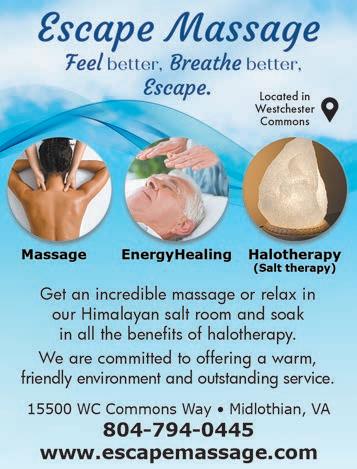
balance the body's circadian rhythms. Jonah has been studying Chinese internal martial arts and qigong since 2011. $5-$25 sliding scale. LivingWaterrva.com 1000 Westover Hills Blvd Richmond, VA.
Ageless Yoga – 10:30-11:45am. A balanced practice that incorporates basic yoga postures, breath awareness and relaxation. Poses are modified to meet individual needs. Students transfer to and from the floor and the class generally includes a vinyasa flow of standing poses, guided by breath for a portion of class time to increase stamina and strength. Students continue to develop body awareness to keep the joins safe, increasing range of motion and improving balance. Glenmore Yoga & Wellness Center, 10442 Ridgefield Pkwy. 804-741-5267. GlenmoreYoga.com.
Tuesday
Beginner-Level Yoga – 9-10:15am. Balanced practice that incorporates basic yoga postures, breath awareness & relaxation. Postures modified to meet individual needs. Online & in-person. $70/4 classes/mo, $20/drop-in. Glenmore Yoga & Wellness Center, 10442 Ridgefield Pkwy. 804-741-5267. GlenmoreYoga.com.
Yoga for Bone Health – 9:45-11am. Increase bone & muscle through the use of yoga with a combination of dynamic & static yoga poses. Chris Riely. $70/4 classes/mo, $20/drop-in. Glenmore Yoga & Wellness Center, 10442 Ridgefield Pkwy. Registration required: 804-741-5267 or GlenmoreYoga.com.
Fundamentals Pilates Mat Class –10:45am-12pm. This Pilates Mat Class with Dianne Powers will include the basic exercises emphasizing alignment, elongation of the spine and healthy posture. It will focus on the execution of efficient movement achieving improved core strength and endurance. $70/4 classes/mo, $20/drop-in. Glenmore Yoga & Wellness Center, 10442 Ridgefield Pkwy. 804-741-5267. GlenmoreYoga.com.
Slow and Gentle Yoga – 11:30am-12:45pm. An in-studio or online class with a yoga therapist. $70 for 4 classes in a month; $20 drop-in. Glenmore Yoga & Wellness Center, 10442 Ridgefield Pkwy. 804-741-5267. GlenmoreYoga.com.
Mixed Level 1 & 2 Yoga – 5-6:15pm. This Mixed Level 1 & 2 yoga class is both instudio and online. End your work day with this yoga class that will move through all the muscles and joints, transitioning from beginner yoga poses into more challenging poses. If joining online, please register in advance to get the Zoom link. $70/4 classes/mo, $20/drop-in. Glenmore Yoga & Wellness Center, 10442 Ridgefield Pkwy. 804-741-5267. GlenmoreYoga.com.
Tuesday Night Gentle Flow into Restoration – 6:30-7:30pm. A nourishing and relaxing 60-minute gentle hatha yoga flow with restorative yoga poses (using
props). Suitable for any level, sliding-scale, drop-in & props provided. Leave feeling relaxed, restored & rejuvenated. Like all Living Water classes, this one is sliding scale, $5-25. Living Water Community Center. 1000 Westover Hills Blvd. LivingWaterrva.com/events.
Men’s Grief Discussion – 1:30-3pm. This group is peer-led, free and a place to listen or share grief experiences with others with similar grief experiences. Open to anyone that has lost a significant other or spouse. Bliley's Funeral Home 3801 Augusta Avenue Richmond, VA 804-355-3800.
Qigong – 5:30-6:30pm. Qigong refers to movement practices developed in ancient China and literally means energy work or energy skill. Qigong movements are done slowly and in harmony with one's mindintention and breath, fully bringing one into the present moment and fostering an alert yet calm state of mind. 804359-0384 Register at InnerworkCenter. org Innerwork Center 213 Roseneath Rd. Richmond, VA $17+.
Wednesday
Yin Yoga (In Studio & Online) – 9-10:30am. This quiet practice with Erin Forsyth, ERYT 500, focuses on the deep connective tissue in the lower back, hips and pelvis. Poses are generally limited to seated or reclined. The poses apply passive pressure to the joints, ligaments and tendons and are held for 3 to 5 minutes. While holding, students practice staying mentally attentive by focusing on the breath and to what their body feels in the pose. For the online class, please register in advance to get the Zoom link. Glenmore Yoga & Wellness Center, 10442 Ridgefield Pkwy. 804-741-5267. GlenmoreYoga.com. $20.
Intermediate Flow Pilates Mat Class –9:15-10:30am. A Pilates mat class with a focus on intermediate mat exercises. $70/4 classes/mo, $20/drop-in. Glenmore Yoga & Wellness Center, 10442 Ridgefield Pkwy. 804-741-5267. GlenmoreYoga.com.
Ageless Yoga – 10:45am-12pm. A balanced practice that incorporates basic yoga postures, breath awareness and relaxation. Poses are modified to meet individual needs. Students transfer to and from the floor and the class generally includes a vinyasa flow of standing poses, guided by breath for a portion of class time to increase stamina and strength. Students continue to develop body awareness to keep the joins safe, increasing range of motion and improving balance. $70/4 classes/mo, $20/drop-in. Glenmore Yoga & Wellness Center, 10442 Ridgefield Pkwy. 804-741-5267. GlenmoreYoga.com.
Gentle Yoga – 11am-12:15pm. This class features gentle yoga stretches, postures, breath awareness and relaxation to improve flexibility, strength, range of motion, balance and energy. Designed for those recovering from injuries, illness, inactivity or other health considerations. $70/4 classes/mo, $20/drop-in. Glenmore Yoga & Wellness Center, 10442 Ridgefield Pkwy. 804-741-5267. GlenmoreYoga.com.
Vino Vinyasa – 12-1pm. Join instructor Ann Marie Lewis for a strong yoga practice that will leave you feeling revitalized on every level! Rinse out your body and mind with a dose of structural, functional flow yoga at beautiful Ashton Creek Vineyard. You are encouraged to stay after class to enjoy some locally produced wine and nibbles! Bring a yoga mat, 2 blocks and a strap. Ashton Creek Vineyard 14501 Jefferson Davis Hwy Chester, VA 804-536-5869. $15. Creative Wink – 5:30-7pm. Join us for a transformative program designed to nurture your creative spirit. Through engaging activities such as simple art, writing, movement, and interactive games, you'll be guided to tap into your innate sense of childlike wonder. 804359-0384 Register at InnerworkCenter.org Innerwork Center 213 Roseneath Rd. $25+.
Thursday
Aerial Yoga – 9-10 am. This beginnerfriendly class for adults of all ages combines traditional yoga with the support of a suspended silk hammock. You will be guided through a series of poses and flows designed to strengthen, lengthen, and open the body, leaving you feeling confident, connected, and relaxed. $20 Host of Sparrows Aerial Circus, 97 Manchester Road, Richmond, VA. 804615-0309. HostOfSparrows.com.
Vinyasa Flow – 9-10:15am. Join Glenmore Yoga's Randi Weiss, E-RYT 500, for an inperson or online Vinyasa Flow class that incorporates all aspects of a traditional Hatha yoga class - postures, breath & meditation while challenging your coordination through flow. Please register in advance. $70/4 classes/mo, $20/dropin. Glenmore Yoga & Wellness Center, 10442 Ridgefield Pkwy. 804-741-5267. GlenmoreYoga.com.
Intermediate Vinyasa Flow – 9:1510:30am. Incorporates all aspects of a traditional hatha yoga class: postures, breath & meditation, while challenging the coordination through flow. In-person & online. $70/4 classes/mo, $20/dropin. Glenmore Yoga & Wellness Center, 10442 Ridgefield Pkwy. 804-741-5267. GlenmoreYoga.com.
Chair Yoga – 10:30-11:45am. This online Chair Yoga class via Zoom for older adults offers a balanced yoga practice which incorporates basic yoga postures, breath awareness and relaxation. Students continue to develop body awareness to keep the joints safe, increase range of motion and improve balance. Please register in advance to get the Zoom link. GlenmoreYoga.com.
Fundamentals Pilates Mat Class –10:45am-12pm. This Pilates Mat Class with Dianne Powers will include the basic exercises emphasizing alignment, elongation of the spine and healthy posture. It will focus on the execution of efficient movement achieving improved core strength and endurance. $70/4 classes/mo, $20/drop-in. Glenmore Yoga & Wellness Center, 10442 Ridgefield Pkwy. 804-741-5267. GlenmoreYoga.com.
YOGAbility – 11am-12:15pm This in-studio therapeutic yoga class is designed to educate, assess and help you progress in everyday life skills including functional abilities of work, rest and play. Highlighted are abilities of aligned posture, dynamic balance and increased mobility. Glenmore Yoga & Wellness Center, 10442 Ridgefield Pkwy. 804-7415267. GlenmoreYoga.com. $20.
Online Beginner Yoga – 6-7:15pm. A balanced practice that incorporates basic yoga postures, breath awareness and relaxation. Postures are modified to meet individual needs. Please register in advance to get the Zoom link for this online class. Glenmore Yoga & Wellness Center, 10442 Ridgefield Pkwy. 804-7415267. GlenmoreYoga.com.
Yin Yoga - 9-10:15am This 75-minute instudio yin yoga class is a great way to end the week. The quiet practice focuses on the deep connective tissue in the lower back, hips and pelvis. Poses are generally limited to seated or reclined. The poses apply passive pressure (muscularly soft) to the joints, ligaments and tendons and are held for 3-5 minutes. Glenmore Yoga & Wellness Center, 10442 Ridgefield Pkwy. 804-741-5267. GlenmoreYoga.com. $20.
Online Tibetan Rites – 10:30am-11:45pm. The Five Tibetan Rites is a system of exercises reported to be more than 2,500 years old. The Rites are said to be a form of Tibetan yoga similar to the yoga series that originated in India. The Five Tibetan Rites enhance mental clarity and memory, balance the hormones, improve health and support emotional well-being. This is an online-only class; please register in advance to get the Zoom link. Glenmore Yoga & Wellness Center, 10442 Ridgefield Pkwy. 804-741-5267. GlenmoreYoga.com. Level 1 & 2 Yoga – 10:45-12pm. This in-studio traditional yoga class takes students beyond the beginner level. The class will flow through poses and include more challenging options, ending with a relaxation session. $70/4 classes/mo, $20/ drop-in. Glenmore Yoga & Wellness Center, 10442 Ridgefield Pkwy. 804-741-5267. GlenmoreYoga.com.
Saturday
Mixed-Level Yoga – 9-10:15am. Start the weekend off right w/a yoga class appropriate for all levels. Guidance given throughout practice, offering individual students a number of appropriate options. In-person & online. $70/4 classes/mo, $20/ drop-in. Zoom. Register, Glenmore Yoga, 804-741-5267 or GlenmoreYoga.com.

Connecting you to the leaders in natural health care and green living in our community. To find out how you can be included in the Community Resource Guide, email Regina@NARichmond.com to request our media kit.
DRS. MAXINE AND JOE ABRETSKI
Omni Family Chiropractic 6806 Patterson Ave. Richmond, VA 23226 804-214-6236

om
We specialize in family-based wellness health care, focusing on correcting the structure of the spine and the function of the nervous system. Our goal is to help families live to their healthiest potential naturally. By addressing spinal alignment and nervous system health, we aim to enhance overall well-being and support longterm health!
WELLCOMEMD
2500 Gaskins Rd, Ste A 866-942-4522 · WellcomeMD.com infoRichmond@WellcomeMD.com

Experience concierge medicine with a functional medicine approach. Comprehensive and proactive, limited number of patients, unhurried 30-minute consultations for a personal and effective relationship with your physician. Schedule a discovery call today. See ad, page 2.
LINDA ZAFFRAM, LCSW, CYT200, PMH-C
Healing Circle Counseling 2819 N. Parham Road, Suite 130 Richmond, VA 23294
804-924-7600
HealingCircleCounseling.com

Linda Zaffram is the founder, owner and CEO of Healing Circle Counseling and Services. Linda’s areas of expertise include adults, women’s issues, depression, panic/anxiety, PTSD, grief/ bereavement, perinatal loss/ stillbirth/miscarriage, perinatal mood disorders, maternal mental health, fertility/reproductive issues, NICU families, emotional, physical & sexual abuse, trauma, birth trauma, stress management, relationship issues, life transitions, communication skill building and developing coping skills. See ad, page 7.
CHERYL DESVERNINE
Braniac Wellness
804-250-3450
BraniacWellness.org

Cheryl is board-certified (BCN) in neurofeedback and has been practicing neurofeedback over the last eight years. We offer neurofeedback, eye movement therapy and traditional counseling to clients ages 6 and up. Neurofeedback is an intervention that improves symptoms associated with ADHD, anxiety, panic, PTSD, trauma, depression and more that is holistic and does not require medication. See ad, page 6.
NEIGHBORS AND HEROD FAMILY DENTISTRY
Dr. Brian Herod 1009 Crowder Dr., Midlothian, VA 23113 804-794-8745 • MidloDental.com

Dr. Brian Herod centers his holistic dentistry practice on the connection between oral and systemic health. He is a member of the IAOMT, providing an integrative approach to dental care. Safe amalgam removal, metal and BPA-free fillings, ceramic implants, biocompatibility testing, fluoridefree, 3-D cone beam.
NANCY A. POWELL, M.D.
River’s Way Healthcare of Virginia 5500 Monument Ave, Ste T 804-379-4560
RiversWayHealthcareVA.com RiversWayVA@gmail.com

Offering expanded healing services. Providing traditional primary care and alternative approaches to support the body’s ability to heal itself. Extensive study in the mind-body connection to achieve optimal health. Certified by the Board of Family Medicine and by the American Board of Scientific Medical Intuition.
VERA DUBOVOY, M.D.
Dubovoy Integrative Health 1404 Starling Dr., Richmond, VA 23229 (Inside the Wellness Village) 757-603-3034
VAIntegrativeHealth.com

Vera Dubovoy, M.D., is dual board-certified in OB-GYN and Lifestyle Medicine. She has over 1,000 hours of training in integrative medicine and functional medicine including health and wellness coaching, nutrition, and herbal medicine. She believes in personalized wellness and nourishing our physical, emotional and spiritual health. She and her husband offer a range of progressive therapies designed to fit the treatment needs of the patient.
PCM INSURANCE AGENCY
Patricia Mayfield PCMInsurance19@gmail.com 1-800-674-6771

PCM Insurance is your premier destination for Medicare enrollment services. With decades of experience in the industry, our dedicated team of experts is committed to helping individuals navigate the complexities of Medicare with ease. See ad, page 2.
HEALTH INSYNCS
9210 Forest Hill Ave, B-3, Richmond 804-377-2222
HealthInsyncs.com

Laser therapy can reduce the pain and swelling of strained muscles and tendonitis, irritated discs and inflamed nerves, and can stimulate tissue repair and regeneration from old and new injuries. See our website for mor e information about laser therapy. See ad, page 12.
ESCAPE MASSAGE
15500 WC Commons Way, Midlothian 804-794-0445
EscapeMassage.com

We offer a variety of massages including Swedish, Therapeutic Swedish, Deep Tissue, Hot Stone, Aromatherapy and CBD. We also offer energy therapy, reiki and halotherapy services. We have a team of professional, experienced, and caring licensed massage therapists and reiki masters ready to cater to your self-care needs. See ad, page 28.
RESETTING TOUCH
MOBILE MASSAGE
571-207-6717
MassageBook.com/biz/resetting-touch

Offering massage services at your location with options including Swedish, Deep Tissue, Trigger Point, Sports, and M.M.A. (Mixed Massage Arts). Couple these services with aromatherapy, CBD, cupping, and guided stretches for full body relaxation. Schedule an appointment today. See ad, page 2.
NARITA C. SNEAD, MPH, MSN, APN-BC
Certified Medical Cannabis Provider
Adult Nurse Practitioner
Registered Practitioner for Medical Cannabis
804-475-8904
Green-Healing.co

Find relief from chronic pain, anxiety and other health conditions with our Medical Cannabis Certification. Get your valid written medical cannabis certification card today. Unlock the natural healing properties of medical cannabis.
MAGNOLIA WELLNESS
Regina Rudolph MagnoliaWell@gmail.com
804-495-0325
Wellness-Teas.com
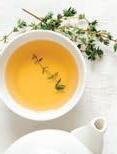
Promoting self-care and disease prevention through the use of our crafted collection of premium wellness teas designed to reduce stress and anxiety, strengthen the immune system, promote weight loss and release harmful toxins. Magnolia Wellness also assists people on their journey to better health and wellness through classes and private sessions. See ads, pages 4 & 17.
DR. MICAH ALLEN, ND, LAC, FABORM
Essential Natural Health
804-464-3315
DrMicahAllen.com

Dedicated to providing personalized holistic healthcare solutions in Richmond, Virginia. Our practice focuses on integrating time-tested acupuncture techniques with innovative medical solutions to achieve significant and enduring results for our patients. Specializing in challenging chronic conditions such as peripheral neuropathy, infertility and pain, we strive to help individuals live fulfilling lives. At Essential Natural Health, we prioritize understanding each patient as a whole person. We develop customized preventive and natural medicine health plans for all ages, from pediatrics to geriatrics. Our approach is grounded in harnessing the body's inherent healing abilities through tailored treatment plans designed to address individual needs effectively.
RX3 COMPOUNDING PHARMACY
12230 Ironbridge Rd, Ste C, Chester 11934 W Broad St, Henrico Ph: 804-717-5000, Fax: 804-717-8300
Rx3Pharmacy.com

RX3, Virginia’s First Nationally Accredited Compounding Phar macy, has been an industry leader for 23+ years. Specialists in customized compounding, bioidentical hormones, veterinary/equine compounding, traditional pharmacy, palliative care, professional quality supplements, CBD experts, Food Inflammation Testing, and more. See ad, page 21.
AWAKEN ENERGY CENTER
Rev. Audra Franta, Mh.D AwakenEnergyCenter.com
Audra@AwakenEnergyCenter.com

Audra is dedicated to helping individuals create a joyful intuitive life through (w) holistic health self-discovery practices such as intuitive readings, guided meditations, divine guidance, energy work, workshops and retreats. Virtual and In-Person Services in Richmond, VA. See ad, page 11.
DEBBIE TROXELL, RN, MSNH Thermographer
The Wellness Village 1404 Starling Dr, Richmond 804-683-7774
RVAThermography.com

Safe, non-invasive, radiationfree imaging. Preserve your breasts, heart health and much more. Live happier and healthier longer! Interpreted by Matthew Lee, MD, RPh. See ad, page 2.
GLENMORE YOGA & WELLNESS CENTER
Far West End Location 10442 Ridgefield Pkwy, Henrico 804-741-5267
Info@GlenmoreYoga.com
GlenmoreYoga.com

Incorporate yoga into your life at Glenmore with in-person and online student-focused, multi-level classes from Ageless Gentle, Beginner and Yin to Vinyasa Flow, Restorative and Meditation. 200- and 300Hour Teacher Training. Voted best Richmond Yoga Center.

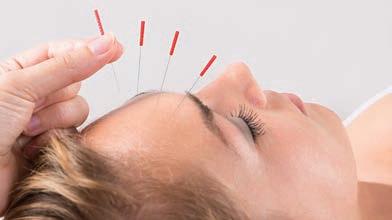










Location: Dewey Gottwald Center at Science Museum of Virginia
Date: October 12, 2024
Time:12-4pm
SPONSORS:



